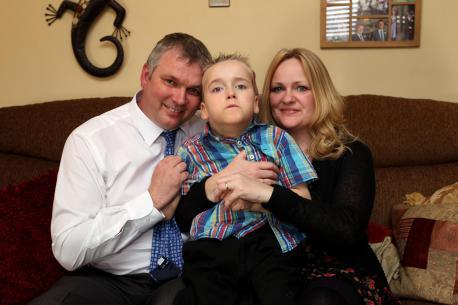
Alfie and Samantha's story
My son has to be changed on the toilet floor
Alfie’s mum, Samantha, shares her experiences, explaining why she often has to change her son on the floor of a public toilet.
“My name is Samantha and I am a mum of 3. My youngest son is 7 years old and was born with quadriplegic cerebral palsy (massive brain damage) due to being starved of oxygen at birth.
We go into town on a regular basis to shop, have lunch, and meet up with other mums for coffee with their disabled children/teenagers in same situation.
When he was 5 years old we were given a RADAR key to access the disabled toilets in Horsham which I was very pleased with, until I actually used the disabled toilet I realised that “disabled loos” are not for the severely disabled/elderly, they are for the limping/walking with sticks or wheelchair users with upper mobility and can get themselves onto a toilet.
If you are severely disabled or paralysed, you need carers to lift you out of the wheelchair and place you on a flat surface to have your continence pad changed.
This is what I am forced to do with my 7 seven year old son, I have to lay him on a urine soaked floor inside the disabled loo, with the 2nd carer standing outside with the wheelchair they have to pass to me the changing accessories through the open door for all passers by to view, this is one of the most awful experiences I have to face every time I come into Horsham Town.”


Why Changing Places are so important
“Thousands of people with physical and/or learning disabilities cannot use standard accessible (disabled) toilets because they cannot walk or stand. They need support from one or two carers to use the toilet or to have their incontinence pad changed. Standard disabled toilets do not provide changing benches or hoists to lift the person on to the toilet or bench. Most are too small to accommodate more than one person.
Without ‘Changing Places’ toilets; the person with disabilities is put at risk; and families/carers are forced to risk their own health and safety by lying their daughter; son or loved one on a toilet floor. This is dangerous, unhygienic, humiliating and undignified. We take it for granted that we would not change a baby on the floor of a public toilet – so why on earth is this acceptable for disabled children?”
Alfie is not alone. Thousands of young people like him have no option but to be lifted onto the floor of a public toilet, to be changed. The person changing them needing to first wipe clean the floor, the best they can, and kneel or place down blankets (which then must also be carried around and later washed).
Many children and adults, with a range of impairments and continence needs, require Changing Places toilets.
Raising awareness does help, as Samantha explains:
“I approached our local council, MP and councillors, and posted a picture of my son laying on the toilet floor on our Town Facebook Page and ‘boom’ people had no idea that severely disabled people have this awful situation to deal with.
Then people wanted to do a story. I have been on BBC Sussex and Surrey Radio, Spirit Fm, and BBC South Today News on the TV, since then our home town are putting in two Changing Places toilets, but it is left up to the families to approach their local Council and rally awareness.”
Samantha is one of many people who are encouraging others to sign petitions for more Changing Places toilets. To sign her petition and support her efforts click here.



 FAQ
FAQ
 Share
Share
